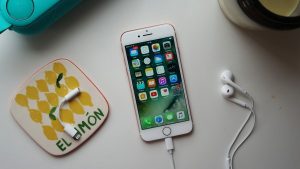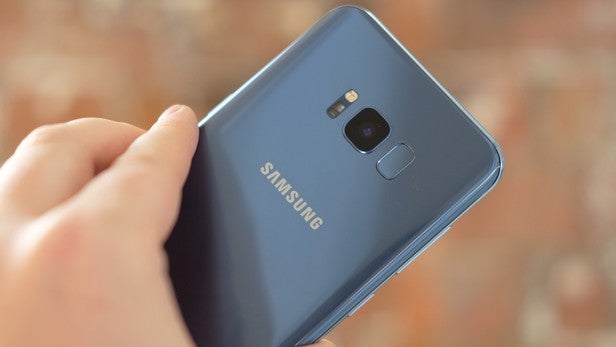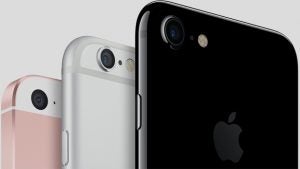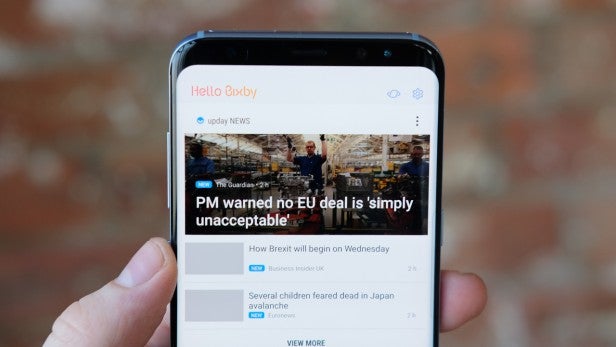Samsung Galaxy S8 vs iPhone 7: Which should you buy?

Samsung Galaxy S8 vs iPhone 7: Which should you choose this year?
The iPhone 7 may now have been superseded by both the iPhone 8 and iPhone X, but Apple is still selling the device, and has even sliced £50 off the asking price. How does it compare with 2017’s best Android phone? Read on to find out.
When Apple launched the iPhone 7 last year, we weren’t overly impressed. While the build quality and features seemed decent enough, battery life hampered the experience enough to warrant a 3.5/5 overall score. Still, the iPhone 7 remains one of the UK’s most popular smartphones, and it’ll be top of the list for many looking to upgrade.
Enter the Galaxy S8, Samsung’s latest flagship and the iPhone’s chief Android rival. With its sloped screen edges, top-spec processor and refined software, it’s an Android flagship that most phones are now measured against.
Read on for a complete guide on how the Samsung Galaxy S8 stacks up against the iPhone 7.
Samsung Galaxy S8 vs iPhone 7 Design: What’s the difference?
It’s easy to claim that smartphones all look the same these days, but the Samsung Galaxy S8 and iPhone 7 are world’s apart when it comes to design.
Apple hasn’t made any significant changes to the iPhone since the introduce of the iPhone 6 back in 2014. It’s still a slim (7.1mm), lightweight (138g) and mostly flat handset, with the exception of a small camera bump.
Related: iPhone 7 vs iPhone 8
 iPhone 7
iPhone 7
By comparison, the Samsung Galaxy S8 is thicker at 8mm, heavier at 155g, and boasts a curvy ‘Edge’-style screen that wraps around the sides of the phone. So it certainly feels more hefty in the hand, which will suit some more than others.
But the main difference is Samsung’s ‘Infinity Display’, which is marketing jargon for a screen that occupies nearly the entire face of the phone. Compared to the iPhone’s lowly 65.6% screen-to-body ratio, most of the Galaxy S8’s front is display. This was made possible by shifting the fingerprint scanner to the back and jacking up the size of the display panel to 5.8 inches (from a previous 5.1 inches). As a result, the Samsung Galaxy S8 has a much bigger screen than the 4.7-inch iPhone 7.
The good news is the dimensions haven’t changed significantly from generation to generation with the Samsung flagship, so the Galaxy S8 measures a still-manageable 148.9 x 68.1 x 8mm, compared to the iPhone 7 at 138.3 x 67.1 x 7.1mm.
 Samsung Galaxy S8
Samsung Galaxy S8
Both phones are waterproof, although the Samsung Galaxy S8 has a better IP68 waterproof certification. This means it’s been tested at depths of 1.5 metres for 30 minutes. By contrast, the iPhone 7 is IP67-certified, which means it survived a more shallow one-metre dunk for 30 minutes.
The Samsung Galaxy S8 is available in, black, silver, and blue colour options, while the iPhone 7 is available in Jet Black, Black, Silver, Gold, Rose Gold and, most recently, (RED).
Related: Galaxy S8 vs Galaxy S8+
Samsung Galaxy S8 vs iPhone 7 specs: Which phone is more powerful?
For a start, the Samsung Galaxy S8 has a 5.8-inch display (or 6.2-inches with the Galaxy S8+). It uses a quirky 18.5:9 aspect ratio, which means you’ll get a seriously widescreen image. You’ll also benefit from a fairly generous QHD+ screen – that’s 2960 x 1440 pixels, giving you an overall pixel density of 567ppi.
 iPhone 7
iPhone 7
By comparison, the iPhone 7 has a much smaller 4.7-inch display with a less impressive 750 x 1334 pixels, which works out at a pixel density of just 326ppi. That means the Galaxy S8 has a significantly sharper display, which means it should be sharper and more detailed. Add that to the fact that Samsung’s Galaxy S8 is using an AMOLED panel, which should have richer colours and better contrast than the LED-backlit LCD screen on the iPhone 7, and we’d expect that the Galaxy S8 screen is far more impressive than the iPhone 7.
In terms of computing power, the Galaxy S8 and iPhone 7 are very different beasts. For starters, the iPhone 7 uses an older Apple A10 Fusion processor, which while not exactly slow, isn’t the latest and greatest as far as processor tech goes. The Qualcomm Snapdragon 835 or Samsung Exynos 8895 in the Galaxy S8 are much more modern and more efficient chips.
But, as we all know, performance isn’t about raw specs, and in actual everyday use we’ve consistently found the iPhone 7 to feel faster, which is a far more important benchmark than any synthetic software you can throw at it.
 Samsung Galaxy S8
Samsung Galaxy S8
I The iPhone 7 has proved itself more than capable with a 12-megapixel camera that boasts a wide f/1.8 aperture and built-in optical image stabilisation (OIS). But Samsung’s Galaxy S8 also features a 12-megapixel shooter with OIS, and an even wider f1/.7 aperture, which means more light can reach the phone’s image sensor – that’s a good thing. In our full reviews, we’ve found the Galaxy S8 to have a superior camera in most situations, but the iPhone 7 isn’t far behind.
The iPhone 7’s front-facing camera turns out 7-megapixel shots, and has a respectable f/2.2 aperture. But Samsung appears to trump Apple on hardware again, offering higher resolution (8MP) selfies, and an exceptionally wide f/1.7 aperture.
While the iPhone 7 may boast waterproofing and a fingerprint scanner, Samsung wins for features. The Galaxy S8 is waterproof and has a fingerprint scanner too, but unlike the iPhone 7, it can be wirelessly charged, unlocked using an iris scanner, and still has a 3.5mm headphone jack too. Better still, base storage starts at 64GB (compared to Apple’s 32GB), and there’s a Micro SD card slot to boot.
Related: Best smartphone
 iPhone 7
iPhone 7
We were unimpressed by the iPhone 7’s usage-per-charge. That’s likely thanks to the teeny 1,960mAh battery, which is a fair whack smaller than the 3,000mAh cell inside the Galaxy S8. The S8 certainly lasts longer, but neither phone will get you beyond a full day of moderate use.
For a full spec comparison, check out the table below:
| Samsung Galaxy S8 | iPhone 7 | |
|---|---|---|
| Screen | 5.8 inches (Super AMOLED) | 4.7 inches (LED-backlit LCD) |
| Display Resolution | 2960 x 1440 (567ppi) | 1334 x 750 (326ppi) |
| Aspect Ratio | 18.5:9 | 16:9 |
| Primary Camera | 12 megapixels | f/1.7 | OIS | 12 megapixels | f/1.8 | OIS |
| Secondary Camera | 8 megapixels | f/1.7 | AF | 7 megapixels | f/2.2 |
| Chipset | Snapdragon 835 (10nm) or Exynos 8995 (10nm) | Apple A10 Fusion (16nm) |
| RAM | 4GB | 2GB |
| Storage | 64GB | 32GB |
| Battery Capacity | 3000mAh | 1960mAh |
| Waterproof? | Yes (IP68 certified) | Yes (IP67 certified) |
| Fingerprint Scanner? | Yes | Yes |
| Headphone Jack? | Yes | No |
| Primary Port | USB Type C | Lightning |
| Iris Scanner? | Yes | No |
| Wireless Charging? | Yes | No |
| Micro SD Slot? | Yes | No |
| Dimensions | 148.9 x 68.1 x 8.0mm | 138.3 x 67.1 x 7.1mm |
| Weight | 155 grams | 138 grams |
| Software | Android 7.0 Nougat | iOS 10 |
Related: Best Android apps
Samsung Galaxy S8 vs iPhone 7 price: Which phone is better value for money?
The iPhone 7 saw Apple kick up the price of its smartphones, initially going on sale with a starting price of £599. With the launch of the iPhone 8, that price has dropped to £549.
The Galaxy S8 is quite a lot more expensive, coming in at £689.
Given the Samsung Galaxy S8 appears to be a better phone on paper, some Android fans may view that higher pricing as justified. But if you’re a die-hard Apple fan, shelling out such a significant amount more may not be appealing.
 Samsung Galaxy S8
Samsung Galaxy S8
Samsung Galaxy S8 vs iPhone 7 Summary: What’s the difference?
Here’s a short breakdown of the key differences between the Samsung Galaxy S8 and Apple’s iPhone 7.
Design: The iPhone 7 is a classic Apple smartphone, and retains a relatively small body, flat screen, and minimalist design. Samsung has thrown caution to the wind, showing off an all-screen front, a curvy ‘Edge’-style display, and near-invisible bezels. That’s why the Galaxy S8 probably wins out in design.
Specs: On paper, the Samsung Galaxy S8 appears to have the edge in terms of hardware, boasting a more advanced processor, as well as better specs and features all round. But Apple is known for its slick optimisation, and it’s won through here again; it feels faster.
Value: The Samsung Galaxy S8 is far more expensive than the iPhone 7, but it seems – on paper, at least – to be the more attractive handset, both in terms of design and specs. It all depends on whether you’re willing to shell out that extra cash per month. Or, indeed, if you simply prefer Apple’s iOS operating system.
What do you think of Samsung’s Galaxy S8? Let us know in the comments.


